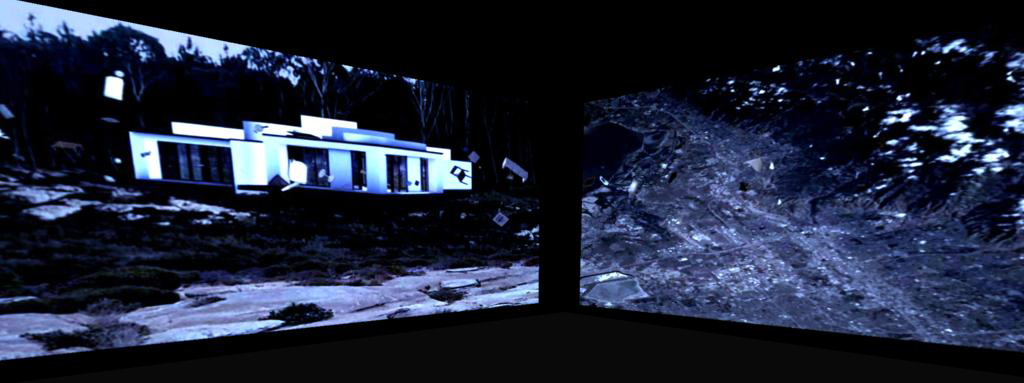Australian artists Joyce Hinterding and David Haines usually pursue separate artistic practices. Recently they have produced two intriguing video installations collaboratively. The Levitation Grounds (2000) and, in this exhibition, The Blinds and the Shutters. Joyce Hinterdings work focuses on a form of installation concerned with energy and sound. At the heart of her work is the exploration of the seemingly invisible phenomena that pervade our daily existence: electricity, the sounds of weather or electro-magnetic fields. Consistent throughout her oeuvre has been the desire to make the invisible visible. In the past she has created lightning on the roof of a Gasometer in Germany, amplified the sounds of magnetic fields and traced the path of electric currents through graphite and paper.
First exhibited in Space Odysseys: sensation and immersion, curated by Victoria Lynne, Art Gallery of NSW and in Deep Space: sensation and immersion, Australian Center for the Moving Image, Melbourne.
David Haines has pursued a video art practice since the late 1980′s that has been concerned with the juncture between hallucination and the landscape. In parallel with this work, his complex paintings of words and phrases display an interest in the role of language. For Joyce Hinterding, reality has always been stranger than fiction. For David Haines, fiction has been stranger than reality.
In the video installation, The Blinds & the Shutters, Haines & Hinterding use computer software and sound recordings to present a virtual world comprised of a modernist fictional house in a remote forest setting, whose contents gradually spill out of every aperture. Shoes and dresses, pots and pans, cutlery, pillows, blankets and plates journey in two directions simultaneously, some disappearing into the distance never to return, others appearing across all four screens in the installation. The larger objects fade up like apparitions, disappear and then re appear in strange locations, breaking all logic that is guiding this imaginary world. The slow drift of these household objects around the four screens is uncanny.
While there journey suggests that the natural phenomenon of air is present, there is also a sense of airlessness; a claustrophobic, almost heavily scented environment. Despite sharing an energy force within the virtual environment, these objects are estranged – for they have lost their domestic relationship with one another. The sounds of bumps, collisions and muffled shuffles emerging from the interior of the house underscores the mystery of this scene. The disturbing atmosphere is most bizarre when the household goods are propelled into outer-space, taking on the form of miniature satellites presumably tracking our behavior from afar. Despite being populated with a plethora of objects from the domestic environment, there are no traces of living beings in this world. It is as if we have arrived in the space after some strange occurrence. After some time, it is not even clear the Blinds and the Shutters exists in our world at all.
The Blinds and the Shutters is not, strictly speaking, a virtual reality (VR) environment, but it makes reference to VR environments. It requires the same suspension of disbelief in the mind of the viewer: an acceptance that the simulated world can be apprehended as a ‘real’ world. In virtual reality environments, ‘reality’ exists as interactive data. As Elizabeth Reid comments, virtual worlds exist in ‘the relationship between internal mental constructs and technologically generated representations of these constructs. The illusion of reality lies not in the machinery itself but in the users willingness to treat the manifestations of his or her imaginings as if they were real’. The irony inherent in the Blinds and the Shutters, is that even though the objects are rendered in as real a manner as possible, their behavior is inexplicable, for they do not perform according to the accepted laws of gravity. Haines and Hinterding have given these objects new rules in which to behave, taking the hyper reality of VR into the realm of Science Fiction.
Blinds and Shutters are located at the threshold of interior and exterior spaces, allowing natural light in, or keeping it out. Blinds and Shutters also create privacy and protection for the occupants of the interior space. In Haines and Hinterdings work, the blinds and the shutters are no where to be seen. The accepted differences between inside and outside, public and private, natural and artificial light are literally thrown ‘out the window’.
Victoria Lynne.
